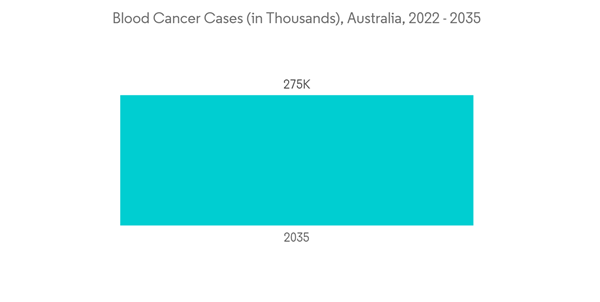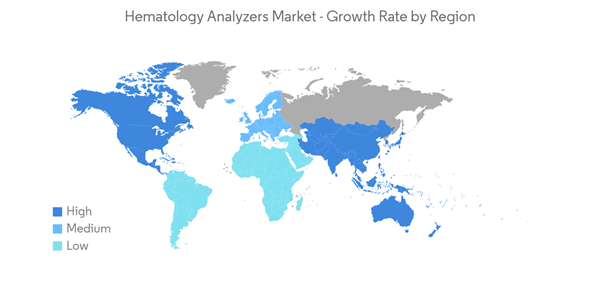The Hematology Analyzers Market size is estimated at USD 6.23 billion in 2024, and is expected to reach USD 8.78 billion by 2029, growing at a CAGR of 7.10% during the forecast period (2024-2029).
There was an increasing focus on the hematology parameters for the assessment of COVID-19 around the world. Various research studies published provide insight into the effects of the pandemic on the market. For instance, in April 2021, a study published in the National Library of Medicine stated that the ongoing COVID-19 pandemic had an impact on the laboratory hematology community. Nevertheless, the pace of COVID-19 hematology-related research has continued to accelerate and has established the role of laboratory hematology data for many purposes including disease prognosis and outcome. However, initiatives such as partnerships by key market players are expected to increase the market growth. For instance, in January 2021, F. Hoffmann-La Roche AG signed a global business partnership agreement with Sysmex Corporation that allows Roche to distribute Sysmex hematology testing products, including instruments and reagents. Thus, with such initiatives, the market is likely to grow over the forecast period.
The major factors for the growth of the hematology analyzers market include the rising burden of blood disorders, increasing technological advancements, and rising adoption rates of automated hematology instruments. Blood disorders have become a global health issue with different causes and are associated with high mortality. Blood disorders, such as anemia, blood cancers, hemorrhagic conditions, and infections in the blood, affect millions of people each year across all age groups. According to the Australian Government, Department of Health and Aged Care report in 2022, more than 330,000 affected infants are born each year (83% sickle cell disorders and 17% thalassaemias), around 7% of pregnant women are carriers of hemoglobin disorders, and over 1% of couples are at risk at a global level.
Similarly, according to the World Federation of Hemophilia report updated July 2022, more than 1,125,000 men worldwide have an inherited bleeding disorder, and 418,000 of those have a severe version of the most undiagnosed disease. Early diagnosis and treatment are the best ways to protect the quality of life of a patient with a blood cell disorder. Hence, the increasing burden of blood disorders is likely to drive the market in the future.
Product launches are another factor in market growth. For instance, in July 2022, CellaVision launched DIFF-Line. CellaVision DC-1 is a single-slide analyzer that automates and digitizes the process of analyzing peripheral blood smears. Thus, such product launches are expected to increase market growth over the forecast period.
However, the high cost of hematology analyzers and time-consuming and stringent regulatory policies associated with the same is restraining the overall market growth.
Ebola Virus is a serious fatal condition that is caused by 4 different species of virus in human and non-human primates. The virus can spread to people through direct contact with the blood, and body fluids, of the person who is having or died from the Ebola virus. It causes hemorrhagic fever which leads to internal and external bleeding and affects multiple organs. The Ebola outbreak in Uganda was declared on September 20, 2022, and it has already spread to seven regions (Kasanda, Kyegegwa, Bunyangabu, and Kagadi districts beyond the original epicenter in Mubende district, and then to Kampala City and Wakiso). Thus, such outbreaks require proper diagnosis to control the spread of the disease which is expected to increase the demand for 3 part hematology analyzer during the forecast period.
Initiatives such as product launches are another factor in market growth. For instance, in April 2022 Sysmex Europe launched its new three-part differential automated hematology analyzer, XQ-320. It is a robust device with low demands for sample volume, bench space, and maintenance in Europe. Thus, the abovementioned factors are expected to increase market growth during the forecast period.
Furthermore, many centers in the state are international leaders in the diagnosis and treatment of blood diseases and collaborate in many research projects to improve diagnosis and treatment options for blood diseases. Many market players are present in the country and are continuously focusing on the development and introduction of novel products. In February 2021 Beckman Coulter launched the DxH 560 AL, a tabletop hematology analyzer designed to reduce time and resource constraints faced by small- to mid-sized laboratories. Similarly, in November 2021, Avricore Health Inc signed a non-exclusive pilot supplier distribution agreement in Canada between HealthTab Inc., a wholly-owned subsidiary, and Abbott, the global healthcare company, concerning the handheld blood chemistry analyzer i-STAT Alinity. Thus, such product launches are expected to increase the adoption of hematology analyzers in the region.
These factors drive the demand for hematology analyzers in the North American region over the forecast period.
This product will be delivered within 2 business days.
There was an increasing focus on the hematology parameters for the assessment of COVID-19 around the world. Various research studies published provide insight into the effects of the pandemic on the market. For instance, in April 2021, a study published in the National Library of Medicine stated that the ongoing COVID-19 pandemic had an impact on the laboratory hematology community. Nevertheless, the pace of COVID-19 hematology-related research has continued to accelerate and has established the role of laboratory hematology data for many purposes including disease prognosis and outcome. However, initiatives such as partnerships by key market players are expected to increase the market growth. For instance, in January 2021, F. Hoffmann-La Roche AG signed a global business partnership agreement with Sysmex Corporation that allows Roche to distribute Sysmex hematology testing products, including instruments and reagents. Thus, with such initiatives, the market is likely to grow over the forecast period.
The major factors for the growth of the hematology analyzers market include the rising burden of blood disorders, increasing technological advancements, and rising adoption rates of automated hematology instruments. Blood disorders have become a global health issue with different causes and are associated with high mortality. Blood disorders, such as anemia, blood cancers, hemorrhagic conditions, and infections in the blood, affect millions of people each year across all age groups. According to the Australian Government, Department of Health and Aged Care report in 2022, more than 330,000 affected infants are born each year (83% sickle cell disorders and 17% thalassaemias), around 7% of pregnant women are carriers of hemoglobin disorders, and over 1% of couples are at risk at a global level.
Similarly, according to the World Federation of Hemophilia report updated July 2022, more than 1,125,000 men worldwide have an inherited bleeding disorder, and 418,000 of those have a severe version of the most undiagnosed disease. Early diagnosis and treatment are the best ways to protect the quality of life of a patient with a blood cell disorder. Hence, the increasing burden of blood disorders is likely to drive the market in the future.
Product launches are another factor in market growth. For instance, in July 2022, CellaVision launched DIFF-Line. CellaVision DC-1 is a single-slide analyzer that automates and digitizes the process of analyzing peripheral blood smears. Thus, such product launches are expected to increase market growth over the forecast period.
However, the high cost of hematology analyzers and time-consuming and stringent regulatory policies associated with the same is restraining the overall market growth.
Hematology Analyzers Market Trends
3 Part Hematology Analyzer is the Segment by Instruments Expected to Hold Significant Market Share Over the Forecast Period
A 3-part differential cell counter uses Coulter's Principle to find the size and volume of the cell. The sample is lysed and dissolved into an electrolyte solution in a container, which also holds a smaller container. 3-part hematology analyzer systems are ideally suited for physician office laboratories, clinics, and small hospitals that perform moderately complex testing. There is increased interest in 5-part hematology analyzers, however, 3-part hematology analyzers are more cost-effective for routine hematological tests. Furthermore, with advancements in technology and the availability of these instruments across the world coupled with affordability the market is projected to have notable growth. Similarly, convenience and accurate results are the two major reasons driving the growth of the segment over the forecast period.Ebola Virus is a serious fatal condition that is caused by 4 different species of virus in human and non-human primates. The virus can spread to people through direct contact with the blood, and body fluids, of the person who is having or died from the Ebola virus. It causes hemorrhagic fever which leads to internal and external bleeding and affects multiple organs. The Ebola outbreak in Uganda was declared on September 20, 2022, and it has already spread to seven regions (Kasanda, Kyegegwa, Bunyangabu, and Kagadi districts beyond the original epicenter in Mubende district, and then to Kampala City and Wakiso). Thus, such outbreaks require proper diagnosis to control the spread of the disease which is expected to increase the demand for 3 part hematology analyzer during the forecast period.
Initiatives such as product launches are another factor in market growth. For instance, in April 2022 Sysmex Europe launched its new three-part differential automated hematology analyzer, XQ-320. It is a robust device with low demands for sample volume, bench space, and maintenance in Europe. Thus, the abovementioned factors are expected to increase market growth during the forecast period.
North America is Expected to Hold Significant Market Share Over the Forecast Period
The market for hematology analyzers in the North American region is growing at a steady pace. This can be attributed to the increasing burden of blood disorders and the growth in the adoption of hematology analyzers by the diagnostic industry. For instance, according to the American Society of Hematology, anemia, which is a common disorder, affects more than three million Americans, particularly women of 'childbearing age. According to the Leukemia and Lymphoma Society in 2021, every three minutes, a person in the United States is diagnosed with blood cancer. An estimated 186,400 people in the United States were diagnosed with leukemia, lymphoma, or melanoma in 2021.Furthermore, many centers in the state are international leaders in the diagnosis and treatment of blood diseases and collaborate in many research projects to improve diagnosis and treatment options for blood diseases. Many market players are present in the country and are continuously focusing on the development and introduction of novel products. In February 2021 Beckman Coulter launched the DxH 560 AL, a tabletop hematology analyzer designed to reduce time and resource constraints faced by small- to mid-sized laboratories. Similarly, in November 2021, Avricore Health Inc signed a non-exclusive pilot supplier distribution agreement in Canada between HealthTab Inc., a wholly-owned subsidiary, and Abbott, the global healthcare company, concerning the handheld blood chemistry analyzer i-STAT Alinity. Thus, such product launches are expected to increase the adoption of hematology analyzers in the region.
These factors drive the demand for hematology analyzers in the North American region over the forecast period.
Hematology Analyzers Industry Overview
The hematology analyzers market is a fragmented market owing to the presence of various market players. Some of the market players are Abbott Laboratories, Beckman Coulter Inc. (Danaher Corporation), Bio-Rad Laboratories, Boule Diagnostics AB, F Hoffmann-La Roche Ltd, Hobira Ltd, Nihon Kohden Corporation, Mindray Medical International Limited (Shenzhen Mindray Bio-Medical Electronics Co. Ltd), Siemens Healthineers, and Sysmex Corporation.Additional Benefits:
- The market estimate (ME) sheet in Excel format
- 3 months of analyst support
This product will be delivered within 2 business days.
Table of Contents
1 INTRODUCTION
4 MARKET DYNAMICS
5 MARKET SEGMENTATION (Market Size by Value - USD million)
6 COMPETITIVE LANDSCAPE
Companies Mentioned (Partial List)
A selection of companies mentioned in this report includes, but is not limited to:
- Abbott Laboratories
- Beckman Coulter Inc. (Danaher Corporation)
- Bio-Rad Laboratories
- Boule Diagnostics AB
- F Hoffmann-La Roche Ltd
- Horiba Ltd
- Nihon Kohden Corporation
- Siemens Healthineers
- Sysmex Corporation
- Stratec Biomedical Systems (DIATRON)
- Ortho Clinical Diagnostics
- Accurex Biomedical Pvt. Ltd.










